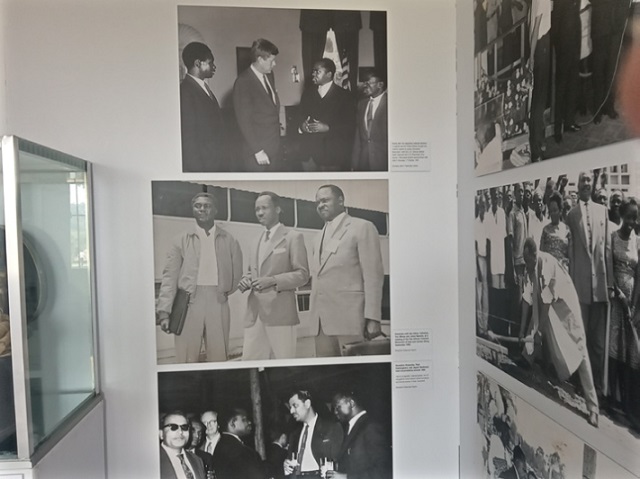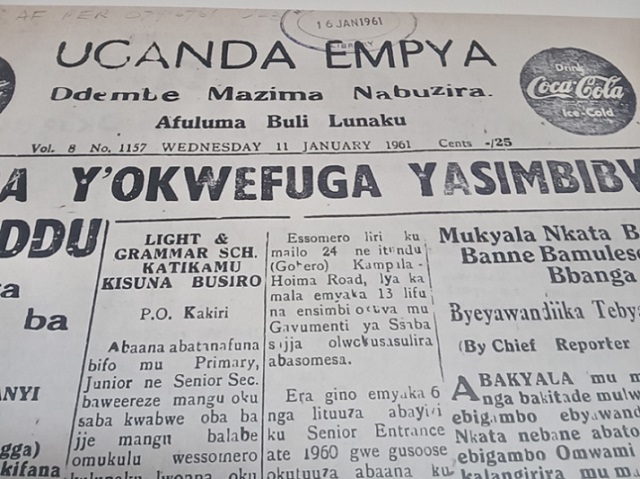
‘Exhibition celebrates the excitement, optimism and promise of 9th October 1962 while acknowledging that, for many Ugandans Independence was partial victory’- Exhibition catalogue
There’re two things that will catch your attention as soon as you walk into the exhibition: Uganda at 60 showing at the Uganda Museum:
Firstly, the black and white photographs juxtaposed with text from newspaper cuttings or photocopied handwritten letters, and secondly, the order and calmness of the subjects in the photographs. These two qualities run through the exhibition that was mounted as part of celebrations to mark the 60 years of Uganda’s independence. At the diamond jubilee, these images that capture the pre and post independence period in Uganda, still resonate with the times. They do not only tell the story of the triumph and sometimes the chaos that marked those years, but communicate a certain level of optimism for the future. Even when hasty preparations were made in London in 1958 to discuss the future of an independent Uganda or the protests of 1959 on the street of Kampala, one aspect unified the citizens: a hope for a better Uganda.
 That is a singular quality that can not be dismissed or ignored as one views the exhibition. It is much visible in the photographs of early women legislators and activists like Joyce Mpanga, Sarah Ntiro and Frances Okello, in the local newspaper publications like Uganda Argus, Munnansi and Uganda Empya that carry ecstatic headlines announcing Uganda’s Independence, and in the mood of Benedicto Kiwanuka as he discussed the theme of students scholarships with President J.F Kennedy at the White House. Yet even in the midst of dissenting voices by political social activists like Haji Busungu and his contemporaries or the Rwenzururu chief Isaya Mukirane’s protests- representing what many ethnic groups across the country interpreted as a form of betrayal from Buganda- there was a sense of nationalism and patriotism that imbued a collective responsibility for the preservation of Uganda’s identity.
That is a singular quality that can not be dismissed or ignored as one views the exhibition. It is much visible in the photographs of early women legislators and activists like Joyce Mpanga, Sarah Ntiro and Frances Okello, in the local newspaper publications like Uganda Argus, Munnansi and Uganda Empya that carry ecstatic headlines announcing Uganda’s Independence, and in the mood of Benedicto Kiwanuka as he discussed the theme of students scholarships with President J.F Kennedy at the White House. Yet even in the midst of dissenting voices by political social activists like Haji Busungu and his contemporaries or the Rwenzururu chief Isaya Mukirane’s protests- representing what many ethnic groups across the country interpreted as a form of betrayal from Buganda- there was a sense of nationalism and patriotism that imbued a collective responsibility for the preservation of Uganda’s identity.
The exhibition is therefore divided into different sections or pavilions that navigate specific themes. The pavilions include Uganda’s Independence, The Boycott of 1959-60, Protest in Rwenzori Mountains and Benedicto Kiwanuka and the Democratic Party. For each of these pavilions, photographs and text that communicate a message attached to the major theme of independence are displayed. For example, the section dedicated to Benedicto Kiwanuka features the background of one of Uganda’s political protagonist who not only participated aggressively in the debate on Uganda’s independence but went on to become Chief Justice of the Republic. The display of Kiwanuka’s judicial wig and his staff may fill the viewer with a great sense of nostalgia.
 It is these instruments that mostly remind us of Kiwanuka as an outstanding political figure who exuded elegance, diplomacy and honesty. In contextualizing the exhibition into the present political climate- which incidentally may have preoccupied the minds of the curators- the exhibition intrinsically offers a platform to re- evaluate ourselves. The mixed sentiments about independence observed in the photographs exhibited, are still present today even as we celebrate the 60 years. There’re obviously wide raging questions on why Ugandans should still celebrate Independence Day, yet political and social strife continue to dominate our every day living. But these questions ultimately seem to serve a wrong purpose: to degenerate our spirit for the future. As pointed out earlier, the protests and mixed reaction before 1962 were not necessarily to deter the spirit of Uganda to go forward- lest the country would have drowned in the mess that followed suit but it was to agitate for equal rights for all Ugandans such that Independence becomes something real for everyone.
It is these instruments that mostly remind us of Kiwanuka as an outstanding political figure who exuded elegance, diplomacy and honesty. In contextualizing the exhibition into the present political climate- which incidentally may have preoccupied the minds of the curators- the exhibition intrinsically offers a platform to re- evaluate ourselves. The mixed sentiments about independence observed in the photographs exhibited, are still present today even as we celebrate the 60 years. There’re obviously wide raging questions on why Ugandans should still celebrate Independence Day, yet political and social strife continue to dominate our every day living. But these questions ultimately seem to serve a wrong purpose: to degenerate our spirit for the future. As pointed out earlier, the protests and mixed reaction before 1962 were not necessarily to deter the spirit of Uganda to go forward- lest the country would have drowned in the mess that followed suit but it was to agitate for equal rights for all Ugandans such that Independence becomes something real for everyone.
The 60 years of Independence are doubtless monumental regardless which side of the fence one may choose to sit on. If Ugandans choose carefully to use them to learn from the past, the next 60 years shall be more triumphant. The order amidst the chaos depicted by pristine uniforms of the army and the optimistic grin on the face of the legislators in the early 1960s should not be missed or otherwise taken for granted.
These were intangible symbols of resilience, optimism and fortitude that have kept this country going until this day.
****
The images on showcase are courtesy of the remarkable photographic archive of Uganda Broadcasting Corporation. The text is sourced from Makerere University Library, archives in Uganda and the United Kingdom, and from private collections of Ugandans who were there.
The exhibition is curated by Dr. Pamela Khanakwa, Dr. Derek. R. Peterson, Dr. David Ngendo Tshimba and Dr. Edgar Taylor.
The exhibition is showing at the Uganda Museum until December
 The Independent Uganda: You get the Truth we Pay the Price
The Independent Uganda: You get the Truth we Pay the Price



Yes Uganda at 60 Years. What about we people who were born in 1962?? I have never heard of anyone concerned about us like other countries
Good comment. I guess there is an umbrella body that recognizes appreciates you and your colleagues. You should ask around or check online.